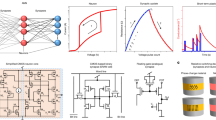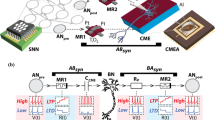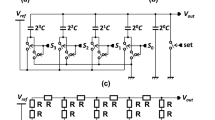Abstract.
The recent quantitative description of activity-dependent depression in the synaptic transmission between cortical neurons has lead to many interesting suggestions of possible computational implications. Based on a simple biological model, we have constructed an analog circuit that emulates the properties of short-term depressing synapses. The circuit comprises only seven transistors and two capacitors per synapse, and is able to reproduce computational features of depressing synapses such as the 1/F law, the detection of long intervals of presynaptic silence and the sensitivity to redistribution of presynaptic firing rates. It provides a useful basis for implementing neural networks with dynamical synapses.
Similar content being viewed by others
Author information
Authors and Affiliations
Additional information
Received: 10 February 2000 / Accepted in revised form: 16 June 2000
Rights and permissions
About this article
Cite this article
Rasche, C., Hahnloser, R. Silicon synaptic depression. Biol Cybern 84, 57–62 (2001). https://doi.org/10.1007/s004220170004
Issue Date:
DOI: https://doi.org/10.1007/s004220170004




